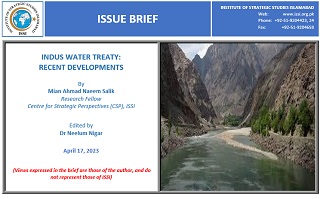Introduction:
On 25 January 2023, India issued a notice to Pakistan conveying its intent to amend the Indus Water Treaty (IWT) within 90 days to guarantee that disputes would be handled between the two nations without any outside interference.[1] The notice of negotiation was issued just two days before the Court of Arbitration (COA), established at Pakistan’s request under the IWT, was to commence and which had been boycotted by India. According to the Attorney General of Pakistan (AGP) office, on April 5, 2023, Pakistan sent a reply to the Indian notice in which it was stated that Pakistan was ready to listen to New Delhi’s concerns about the prevalent treaty at the level of the Permanent Commission of Indus Waters (PCIW). The decision about the parleys on changes to the Treaty will be taken once Pakistan hears India’s concerns at the PCIW level. However, under Article XII, the existing Treaty will continue to reign unless the parties to the dispute, Pakistan and India, bilaterally introduced changes to the pact.[2]
An overview of the Indus Water Treaty:
The Indus Basin system is the major water reservoir in the subcontinent. It comprises six major rivers: three western rivers (Indus, Jhelum, and Chenab) and three eastern rivers (Sutlej, Beas, and Ravi). It cuts across both Pakistan and India. The geography of partition was done in such a way that headworks of the rivers entering Pakistan fell within the Indian territory. Thus, India emerged as an upper riparian with control over the canal headworks that supplied water to the province of Pakistani Punjab, once the breadbasket of British India and now a lower riparian. This left Pakistan with a feeling of water insecurity from the very beginning.[3]
















